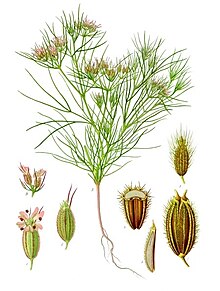Cumin
| Cumin | |
|---|---|
 |
|
| Scientific classification | |
| Kingdom: | Plantae |
| (unranked): | Angiosperms |
| (unranked): | Eudicots |
| (unranked): | Asterids |
| Order: | Apiales |
| Family: | Apiaceae |
| Genus: | Cuminum |
| Species: | C. cyminum |
| Binomial name | |
|
Cuminum cyminum L. |
|
| Nutritional value per 100 g | |
|---|---|
| Energy | 1,567 kJ (375 kcal) |
|
44.24 g
|
|
| Sugars | 2.25 g |
| Dietary fibre | 10.5 g |
|
22.27 g
|
|
| Saturated | 1.535 g |
| Monounsaturated | 14.04 g |
| Polyunsaturated | 3.279 g |
|
17.81 g
|
|
| Vitamins | |
| Vitamin A equiv. |
(8%)
64 μg
(7%)
762 μg |
| Vitamin A | 1270 IU |
| Thiamine (B1) |
(55%)
0.628 mg |
| Riboflavin (B2) |
(27%)
0.327 mg |
| Niacin (B3) |
(31%)
4.579 mg |
| Vitamin B6 |
(33%)
0.435 mg |
| Folate (B9) |
(3%)
10 μg |
| Vitamin B12 |
(0%)
0 μg |
| Choline |
(5%)
24.7 mg |
| Vitamin C |
(9%)
7.7 mg |
| Vitamin D |
(0%)
0 μg |
| Vitamin D |
(0%)
0 IU |
| Vitamin E |
(22%)
3.33 mg |
| Vitamin K |
(5%)
5.4 μg |
| Minerals | |
| Calcium |
(93%)
931 mg |
| Iron |
(510%)
66.36 mg |
| Magnesium |
(262%)
931 mg |
| Manganese |
(159%)
3.333 mg |
| Phosphorus |
(71%)
499 mg |
| Potassium |
(38%)
1788 mg |
| Sodium |
(11%)
168 mg |
| Zinc |
(51%)
4.8 mg |
| Other constituents | |
| Water | 8.06 g |
|
Reference
|
|
|
|
| Percentages are roughly approximated using US recommendations for adults. Source: USDA Nutrient Database |
|
Cumin (/ˈkjuːmᵻn/ or UK /ˈkʌmᵻn/, US /ˈkuːmᵻn/) (Cuminum cyminum) is a flowering plant in the family Apiaceae, native from the east Mediterranean to South Asia.
Its seeds (each one contained within a fruit, which is dried) are used in the cuisines of many different cultures, in both whole and ground form. It also has many uses as a traditional medicinal plant.
The English "cumin" is derived from the Old English via Latin cuminum from the Greek κύμινον (kyminon), which is related to Hebrew (kammon) and Arabic (kammūn).
Cumin is the dried seed of the herb Cuminum cyminum, a member of the parsley family. The cumin plant grows to 30–50 cm (12–20 in) tall and is harvested by hand. It is an annual herbaceous plant, with a slender, glabrous, branched stem that is 20–30 cm (8–12 in) tall and has a diameter of 3–5 cm ( 1 1⁄4–2 in). Each branch has two to three sub-branches. All the branches attain the same height, therefore the plant has a uniform canopy. The stem is coloured grey or dark green. The leaves are 5–10 cm (2–4 in) long, pinnate or bipinnate, with thread-like leaflets. The flowers are small, white or pink, and borne in umbels. Each umbel has five to seven umbellts. The fruit is a lateral fusiform or ovoid achene 4–5 mm ( 1⁄6– 1⁄5 in) long, containing two mericarps with a single seed. Cumin seeds have eight ridges with oil canals. They resemble caraway seeds, being oblong in shape, longitudinally ridged, and yellow-brown in colour, like other members of the Umbelliferae family such as caraway, parsley, and dill.
...
Wikipedia
